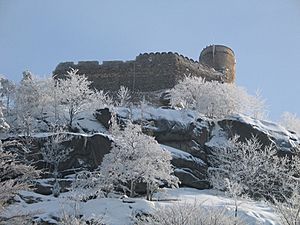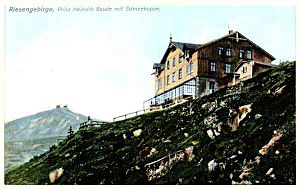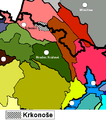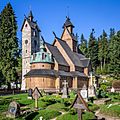Karkonosze facts for kids
Quick facts for kids Krkonoše / Karkonosze |
|
|---|---|

Sněžka – the highest peak of Krkonoše
|
|
| Highest point | |
| Peak | Sněžka / Śnieżka |
| Elevation | 1,603 m (5,259 ft) |
| Naming | |
| Etymology | "krak"+"noš" (see Names) |
| Geography | |
| Countries | Czech Republic and Poland |
| States/Provinces | Liberec Region (CZ), Hradec Králové Region (CZ) and Lower Silesian Voivodeship (PL) |
| Range coordinates | 50°46′N 15°37′E / 50.767°N 15.617°E |
| Borders on | Jizera Mountains and Rudawy Janowickie |
| Subdivisions |
List
Western Krkonoše Mountains
Eastern Krkonoše Mountains Wielki Staw Mały Staw Rivers: Elbe Jizera Úpa Mumlava Bóbr Kamienna |
| Geology | |
| Orogeny |
|
| Age of rock | Neoproterozoic and Paleozoic |
| Type of rock |
|
The Krkonoše or Giant Mountains are a mountain range. They are found in the northern Czech Republic and southwestern Poland. These mountains are part of the Sudetes system. The border between the Czech Republic and Poland runs along the main ridge. This border also separates the old regions of Bohemia and Silesia. The highest point is Sněžka, which is 1603 meters (5259 feet) tall. It is the highest peak in the Czech Republic.
Both the Czech and Polish sides of the mountains have large national parks. These are the Krkonoše National Park in the Czech Republic and the Karkonosze National Park in Poland. Together, they form a special biosphere reserve recognized by UNESCO. The River Elbe starts its journey in the Krkonoše mountains. These mountains are a popular place for tourists. People come here for skiing, hiking, and cycling.
History of the Giant Mountains
For a long time, the Giant Mountains and their nearby areas were empty. They had thick, wild forests. The first signs of people living here appeared around the 12th century. These early settlements were in the Duchy of Bohemia. They were near two old paths that connected Bohemia and Silesia.
The first group of settlers were Slavonic people. This happened in the 13th century in the Kingdom of Bohemia. But they only settled in the lower parts of the mountains. The higher ridges still had no people living on them. A second group of settlers arrived in the late 13th century. Most of these were German settlers. They first moved to the northern, Silesian side. This area had better conditions for farming. Many farms, markets, and towns were started during this time. These new communities helped more people move into the mountain range.
The first people to explore the deep parts of the Krkonoše were treasure hunters and miners. They were looking for gold, silver, other metals, and valuable stones. Most of this search happened on the Silesian side. In the 14th and 15th centuries, some foreigners came to the mountains. They spoke a language that was not German. These people were called "Wallen." Their trips to find "treasure" were written down in special books called "Wallenbüchern." Even today, you can still see mysterious signs left by these "Wallen." They are especially visible on the northern side of the mountains.
The Krkonoše is famous as the home of Rübezahl. He is a legendary goblin from German folklore. Sometimes he is mischievous, and sometimes he is friendly.
Mountain Huts and Rock Formations
The Krkonoše mountains are known for their many mountain huts. In Czech, these huts are called bouda. In German, they are called Baude. Both names come from an old German word, Buode, which means a small building or booth. Some groups of huts were named after the families who lived there. These huts are found in the higher parts or along the ridge of the Krkonoše. Shepherds used them as wooden shelters during the summer months.
After the year 1800, some of these mountain huts became interesting to early hikers. By the late 1800s, many huts were turned into hostels for visitors. Later, these huts were often made bigger to host more guests. In some places, the old huts were replaced with new buildings. These new buildings were built especially for tourists. Examples of huts built in the 20th century include Petrova bouda and the hut on the top of Mount Sněžka/Śnieżka.
You can also see many amazing rock formations along the main ridge. These are blocks of granite that have been shaped by the weather over time. They form tall towers that often look like humans or animals. Some of these rock towers can reach heights of up to 30 meters (98 feet).
Images for kids
-
Dead spruces on the northern, Polish side of the range
-
Koppenträger, who in former times supplied the mountain huts during most of the year. The picture shows members of the Hofer and Mitlöhner families, two long-established dynasties from the eastern part of the Bohemian side of the mountains. The ancestors of both families came from Austria in the 16th century.
-
Morning in the Riesengebirge, early 1810s painting by Caspar David Friedrich
-
A Ski resort in Pec pod Sněžkou
-
Riſenberg on Martin Helwig's map of Silesia, 1561
-
Panorama of the Giant Mountains from the south (from the Czech Republic
-
Panorama of Giant Mountains from the north (from Poland) in winter
-
Panorama of Giant Mountains from the north (from Poland) in summer
-
Panorama of Giant Mountains from the north (from Poland) in winter
See also
 In Spanish: Montañas de los Gigantes para niños
In Spanish: Montañas de los Gigantes para niños


















